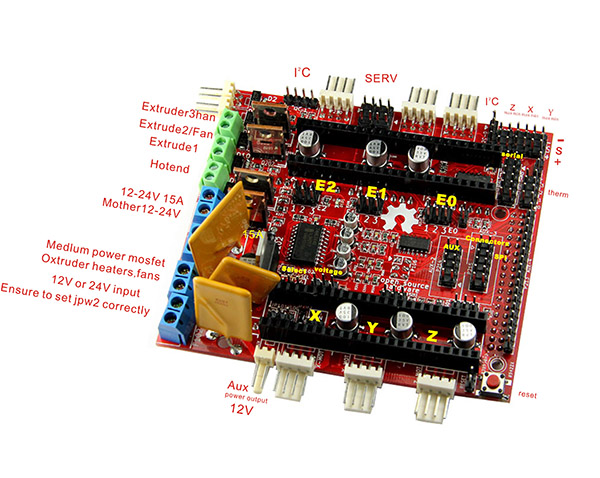I recently moved to a new job, and immediately bought a 3D printer for the lab. I found a good deal on a used Makerbot Replicator 2x- saved about a grand off the price of a new one.
Up until I fired it up, I have had a lot of experience with the Afina printer, my home built Mendelmax, and am in the process of designing / building a Rostock / Wolfstock delta bot clone- but no experience with Makerbot products.
Initial impressions were decent- it seemed to be a step up from the Afina- slightly more solid construction, and the software was more polished. Print quality seems to be very good, especially at the 0.1mm layer height.
But....
- Printing on glass would require some modifications- using PET / kapton / polyimide sheet is a pain to use and is expensive. Since the platform isn't removable, and doesn't easily accommodate a removable glass sheet, Kapton tape is applied directly to the platform, and parts have to be removed from the platform. If parts are stuck, you are forced to use a putty knife and a few sharp taps from a hammer to break the part loose. Am I the only person who is disturbed by literally hammering on a delicate $2k+ machine?
- The platform isn't perfectly flat- it bows upward in the center slightly. This hasn't appreciably affected part quality, but I'm sure it at least slightly affects it.
- The stock filament drive system isn't very reliable, and easily jams / stalls. This is easily rectified by downloading and printing an upgrade from Thingiverse and adding the appropriate hardware. Which, strangely enough, Makerbot sells on their website. (but doesn't fix the root problem- their filament feeder design)
The extruder / filament feed upgrade is a must do in my book. When I first set up the printer I was having constant feeding issues- probably 50% of the time the print would fail because the extruder would mysteriously stop feeding filament. I took apart the print head, adjusted the spring tension, etc, but to no avail. I ended up installing this upgraded filament extruder design:
http://www.thingiverse.com/thing:94979
I purchased two copies of the Makerbot hardware kit from Makerbot.com. It was quick and easy to install, and immediately solved the filament feed issue. It has been 100% reliable ever since I installed it, on every filament I've tried.
 |
| Stock Makerbot R extruder mechanism (removed from drive motor) |
After taking apart the stock extruder, it was easy to see why it had problems. Very small spring, limited travel- even with the tension screw cranked down all the way it didn't have enough travel to accommodate any changes in filament diameter / roundness / compression.
 |
| New Makerbot R extruder mechanism (on drive motor) |
The replacement drive mechanisms have a large spring, and the idler wheel has lots of travel to accommodate any conceivable variation in filament thickness.
 |
| Stock Makerbot L extruder, on drive motor |
 |
| Replacement L drive mechanism |
 |
| Stock extruder, back side. Loading / de-tensioning lever at the top, idler wheel at the lower left |
 |
| De-tensioning lever removed- tension spring visible- tiny! |
 |
| Both L and R new extruder feed mechanisms installed and ready to go! |
 |
| Warmed up and ready to print |
Bottom line, the Makerbot Replicator 2x is a nice unit and produces good quality prints- after some modification. Personally I'm glad I built my own, but I have the patience to tweak my home-built machine and really tune it for good performance. There is still some of that with the 2x, but it's much, much closer to a plug-and-play John-Q-public consumer friendly appliance.
One big benefit of the Makerbot Replicator 2x is that it has two extruder heads- allowing you to print two materials on the same part. You could use two colors, or, print a dissolvable support structure, allowing for more complex parts. I'm trying to print complex 3D models of the vascular system, so being able to dissolve a printable support structure is very useful.
Makerbot sells their "dissolvable" filament for this purpose- which is actually HIPS - high impact polystyrene. They recommend a chemical called d-limonene to dissolve it. Unfortunately this isn't something you are going to find at Home Depot in the concentration necessary to actually dissolve HIPS.
I ordered
this gallon of d-limonene off of amazon.com:
 |
| Gallon of orange-scented nastiness |
Just because it smells like oranges doesn't mean it's good for you. This stuff actually started dissolving a plastic putty knife I was using to clean up a part. So make sure to wear gloves, protective facegear, and work in a well ventilated area when using it. It also seems like using glass, HDPE, PP, wood, or other chemical resistant containers and tools is required.
 |
| Using a sterilite plastic container to soak the parts |
 |
| Starting to scoop out the HIPS support |
 |
| Yummy! |
30 minutes of soaking really softened up the HIPS, allowing easy scooping of the material. It seems like removing as much material as possible and letting the d-limonene only dissolve the bare minimum of plastic is a good idea. The D-limonene isn't cheap, and conserving it makes sense. A soak of 2+ hours seems required to really clean off all remaining HIPS off of the ABS part.
Bottom line, using a dissolvable support structure is smelly, messy, and seems worth it only if the parts you are printing have very complex geometry and would be difficult to clean up using an ABS support structure.
























































